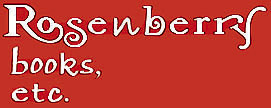“The typographer must analyze and reveal the inner order of the text, as a musician must reveal the inner order of the music he performs … The typographic performance must reveal … the inner composition. Typographers, like other artists and craftsmen—musicians, composers and authors as well — must as a rule do their work and disappear.”
— The Elements of Typographic Style by Robert Bringhurst
Writers of haiku, tanka, senryu, etc. care about the little things, this much I know. In each poem, your canvas is so small that every little element is significant.
Correspondingly, when short forms come to print, every little design element — page shape and margins; poem arrangement and justification; font selection, size, letterfit and leading; the design of folios, running heads and footers (to throw some terms at you) — can assist, or serve to ruin what you have so carefully created.
I want to see your poetry better served. That is the purpose of my design work at Rosenberry Books and that is the purpose of this new column about typography. A word of warning that I know you will understand: tips do not an artist make. Yet I am a devoted do-it-myselfer, and I like tips for becoming a better novice.
With internet use and texting, everyone is typing. Without thinking about it, self-publishers and self-styled typographers of newspapers, magazines and books are bringing into print modes that work well on computers and cell-phones. In print however, many such techniques interfere with the functional and aesthetic experience of reading.
Why do we care about typography — what is it for? Let’s start with the obvious — readability. Readability is not the same thing as legibility. Unlike the handwriting of many members of my family, most all the fonts that came with your computer can be read at some size. Readability takes legibility to the next level: can you read the text comfortably and effortlessly?
Reading legible paragraphs of capitalized letters is difficult. Besides the feeling of being shouted at, the familiar shape of words (by which we efficiently read) is lost. Likewise, a big font with little space between lines (leading) can be as difficult to read as a squintingly small font.
Selecting a font style and size (considering weight, x-height, ascender and descender length …) that is in proper relation to the leading, which is also in proper relation to the column width, is a good start towards readability. The best thing to do with this bit of information is to start noticing this issue whenever you are reading.
Short lines of all caps, such as in titles, can be readable and appropriate. Why not, then, use all caps in a short poem?
A title is like an announcement. Think of the pace and tone of voice that is typical of a spoken announcement. Is that the quality desired for the reading of a haiku? But I am getting ahead of myself. “Expression” will be a fine subject for a future column …
“Typography Tips for Poets,” a column in Moonset Literary Review, was written by
Diane Katz, book designer, Rosenberry Books
Diane can be reached at 800.723.0336 diane@rosenberrybooks.com



